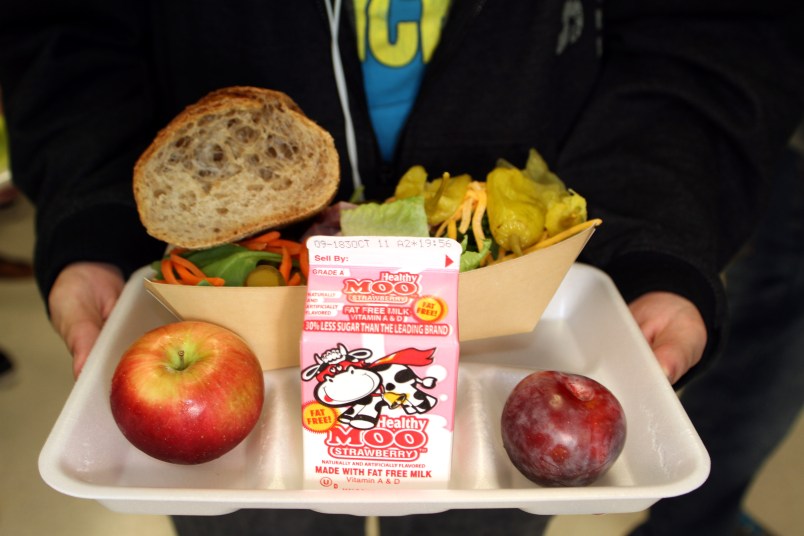LEESBURG, Va. (AP) — Schools won’t have to cut more salt from meals just yet and some will be able to serve kids fewer whole grains, under changes to federal nutrition standards announced Monday.
The move by the Trump administration partially rolls back rules championed by former first lady Michelle Obama as part of her healthy eating initiative.
As his first major action in office, Agriculture Secretary Sonny Perdue said the department will delay an upcoming requirement to lower the amount of sodium in meals while continuing to allow waivers for regulations that all grains on the lunch line must be 50 percent whole grain.
Schools could also serve 1 percent flavored milk instead of the nonfat now required.
“If kids aren’t eating the food, and it’s ending up in the trash, they aren’t getting any nutrition — thus undermining the intent of the program,” said Perdue, who traveled to a school in Leesburg, Virginia, to make the announcement.
Before he signed the proclamation, Perdue and Senate Agriculture Chairman Pat Roberts, R-Kansas, ate chicken nuggets, fruit and salad with children at Catoctin Elementary. Perdue said he doesn’t see the changes as a rollback, but “we’re just slowing down the process.” He praised Obama’s nutrition efforts as first lady but said he wants the healthier meals to be more palatable.
He said the department will work on long-term solutions to further tweak the rules.
The changes reflect suggestions from the School Nutrition Association, which represents school nutrition directors and companies that sell food to schools. The group often battled with the Obama administration, which phased in the healthier school meal rules starting in 2012.
The Obama administration rules set fat, sugar and sodium limits on foods in the lunch line and beyond. Schools have long been required to follow government nutrition rules if they accept federal reimbursements for free and reduced-price meals for low-income students, but these standards were stricter. Obama pushed the changes as part of her “Let’s Move” campaign to combat childhood obesity.
The Trump administration changes leave most of the Obama administration rules in place, including rules that students must take fruits and vegetables on the lunch line. Some schools have asked for changes to that policy, saying students often throw them away.
But health advocates who have championed the rules are concerned about the freeze in sodium levels, in particular. School lunches for elementary school students are now required to have less than 1,230 mg of sodium, a change put in place in 2014. The changes would keep the meals at that level, delaying until at least 2020 a requirement to lower sodium to 935 mg. That requirement was scheduled to begin in the 2017-2018 school year.
“By forgoing the next phase of sodium reduction, the Trump Administration will be locking in dangerously high sodium levels in school lunch,” said Margo Wootan, a lobbyist for the Center for Science in the Public Interest.
Becky Domokos-Bays, the nutrition director for Loudon County, Va., including Catoctin Elementary, said she has been experimenting with the lower sodium levels and she’s had a hard time adjusting some of the more popular foods she serves. Kids like her chicken noodle soup, she says, but rejected it when she lowered the sodium content because it was thinner and had less taste.
As the healthier school meals have now been in place for five years, many schools and school children have gotten used to them. But nutrition directors like Domokos-Bays have said some parts of the law are still causing them trouble, such as finding tasty foods that are high in whole grains. In addition to the grits, nutrition directors have said they have a hard time finding whole grain pastas, biscuits and tortillas that kids will eat.
Perdue, a former governor of Georgia, said some schools in the South have had problems with grits, because “the whole grain variety has little black flakes in it” and kids won’t eat it.
“The school is compliant with the whole-grain requirements, but no one is eating the grits,” Perdue said. “That doesn’t make any sense.”
Others don’t want to see any changes to the healthier meals. Outside the school, Leesburg mayor Kelly Burk and about 20 others protested ahead of the announcement. One sign read: “Sonny — Our children do not want big business soda, chips and fries!”
“Some people don’t like regulations, but these are important regulations that impact kids,” Burk said.
Copyright 2017 The Associated Press. All rights reserved. This material may not be published, broadcast, rewritten or redistributed.







How the hell does reducing salt make a soup thinner? Any culinary chemists want to explain that?
… if only they could declare ketchup a vegetable.
To get under the limit she probably diluted it water or used low or no salt broth in the soup.
I remember when Michelle Obama promoted the concept of drinking more water and staying well hydrated. Republicans had a fit. I was kind of hoping she would promote a problem on deep breathing and Republicans would refuse to breathe.
She used a hell of a lot of salt I guess.
Hi Johnny, would you like some broth with your salt?
And this, besides vindictiveness, accomplishes what exactly?